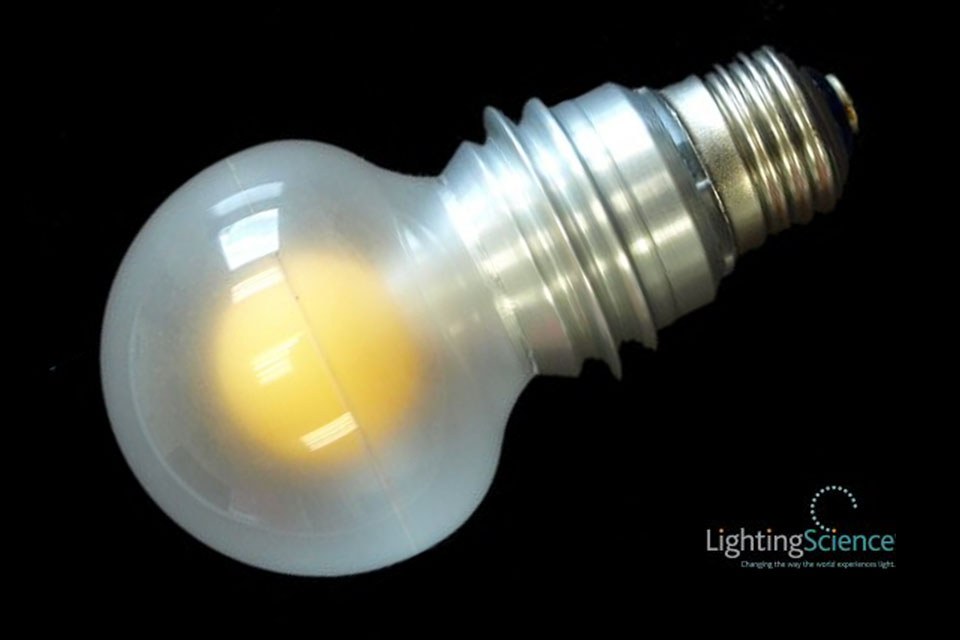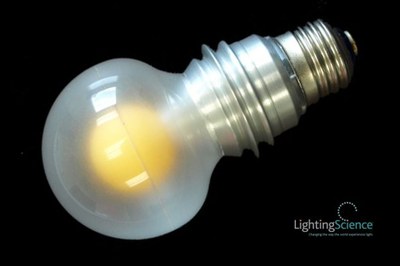Lighting Science Group Pursues Prestigious L Prize with Revolutionary New LED Bulb
Lighting Science Group Corporation, a leading American maker of LED lighting, today notified the U.S. Department of Energy (DOE) that it has developed with Light Prescriptions Innovators, LLC (LPI) a highly efficient, high output and low cost 60-watt replacement LED bulb, and will submit it for testing to win the Bright Tomorrow Lighting Prize (L Prize) competition. The bulb design is based on patented and patent-pending technologies developed by both companies.
The Energy Independence and Security Act of 2007 established the L Prize to promote the development of a highly efficient, high quality LED replacements for the traditional 60-watt light bulb—the most widely used light bulb in America. Incandescent lights are wasteful and energy-hungry—DOE estimated that lighting accounted for 25% of all electric energy use in the U.S. in 2009—offering a rapid and practical path for significant energy savings from LED lighting.
The L-Prize criteria seemed futuristic when first announced, requiring a light bulb that works in current sockets and gets six times the energy efficiency (measured in lumens of light produced per watt of electricity used) of an incandescent and almost double the efficiency of a compact florescent lamp, while meeting other high standards for color rendering, life, quality, cost and availability.
“This bulb is yet another example of how Lighting Science Group is revolutionizing the science of light to produce LED products that deliver on the promise of LED technology and further it’s widespread adoption, right here in America,” said Fred Maxik, founder and chief technology officer of Lighting Science Group. “We are confident that our LED bulb developed in partnership with LPI meets or exceeds all of the criteria for the L Prize, making it a strong contender to win the competition, but we also believe that developing this product will further accelerate the transformation of the lighting industry to highly efficient LED technology.”
“This LED bulb will help accelerate America’s shift away from inefficient, dated lighting products to innovative, high-performance products,” said Roberto Alvarez, chief executive officer and president of LPI. “We applaud the U.S. government for challenging the industry through this contest to develop affordable and ultra-efficient LED bulbs that meet real-world user demands.”
Lighting Science Group is an American success story—a U.S.-based company that last year created 465 jobs making LED light bulbs in its Satellite Beach, Florida headquarters facility, and was the first lighting company to receive an ENERGY STAR approval for an LED light bulb. With the manufacture of more than one million units during the second half of 2010 alone, the company believes it is one of the largest worldwide suppliers of LED retrofit lamps. The company is already producing advanced 60-watt replacement A19 LED light bulbs that are affordable, ultra-efficient and omni-directional; and sees strong commercial potential for it’s new bulb: “About half of all residential light sockets have a 60-watt bulb in them today, and our new bulb uses only about a sixth of the energy and last about 50 times longer than the incandescent bulb that is in there now,” said Rich Weinberg, chairman and chief executive officer of Lighting Science Group. “And because they are affordable, people will save money immediately through significant electricity savings, quickly paying for the cost of the bulb. We expect this to be a significant product for us.” Importantly, the bulb is made without any of the toxic mercury that is in every florescent light including the popular compact florescent lamp (CFL).
In addition to a significant cash prize, the first manufacturer to fully meet the competition’s requirements will also be in consideration for federal purchasing agreements, utility programs and other incentives. However, the stakes are much higher than that. Energy efficiency means cost savings for the consumer, but on a national scale it also means less reliance on imported fossil fuels, greater national energy security, reduced pollution, and more innovation-driven clean-tech American jobs. According to DOE, an LED replacement for the approximately 425 million 60-watt incandescent bulbs sold each year could save 34 terawatt-hours of electricity in one year, enough to power the lights of 17.4 million U.S. households and avoid 5.6 million metric tons of carbon emissions annually.
The L Prize’s stringent requirements and targets for the 60-watt incandescent LED replacement, as laid out by the U.S. Department of Energy, include:
• Efficacy of more than 90 lumens (light output) per watt (exceeds the efficiency of all incandescent and most compact fluorescent sources today, which range from 10 to 60 lumens per watt);
• Energy consumption of less than 10 watts;
• Output of more than 900 lumens;
• Lifetime of more than 25,000 hours (25 times greater than a typical incandescent bulb);
• Color Rendering Index (CRI) greater than 90 (a high measure of lighting quality);
• Color Temperature between 2700 – 3000 degrees Kelvin;
• An even omni-directional light distribution; and
• A consumer retail price starting at $22.
Additional details about the L Prize competition are available at www.lightingprize.org/.
About Light Prescriptions Innovators:
Light Prescriptions Innovators (LPI) is a world leader in the field of nonimaging optics. A One-Stop design, prototype fabrication and manufacturing firm, LPI is making a positive difference in saving energy. LPI specializes in state-of-the-art optical solutions in both Solid State Lighting and Concentrated Photovoltiacs solar. Its advanced designs employ the latest and best principles in the fields of both nonimaging and imaging optics. LPI’s extensive portfolio of patented optical inventions includes many new optical design methods such as the 2D and 3D Simultaneous Multiple Surface (SMS) design methods and their related family of optics, the most advanced optical design method available today The company has R&D and design offices in Altadena, California and Madrid, Spain and a prototyping and manufacturing subsidiary in Hong Kong. More information about LPI is available at www.lpi-llc.us/.
About Lighting Science Group:
Lighting Science Group Corporation (OTCBB: LSCG) designs, develops, manufactures and markets LED lighting solutions that are environmentally friendlier and more energy efficient than traditional lighting products. Lighting Science Group offers retrofit LED lamps in form factors that match the form factor of traditional lamps or bulbs and LED luminaires for a range of applications including public and private infrastructure for both indoor and outdoor applications. Lighting Science Group Design Works business unit designs, develops and manufactures custom LED lighting solutions for architectural and artistic projects. Lighting Science Group is headquartered in Satellite Beach, Florida; the Company’s European operations are based in Goes, The Netherlands; and, the Company has a sales office in Sydney, Australia. Lighting Science Group employs approximately 600 workers building lighting products from domestic and imported parts. Lighting Science Group is a Pegasus Capital Advisors portfolio company. More information about Lighting Science Group is available at www.lsgc.com/.


